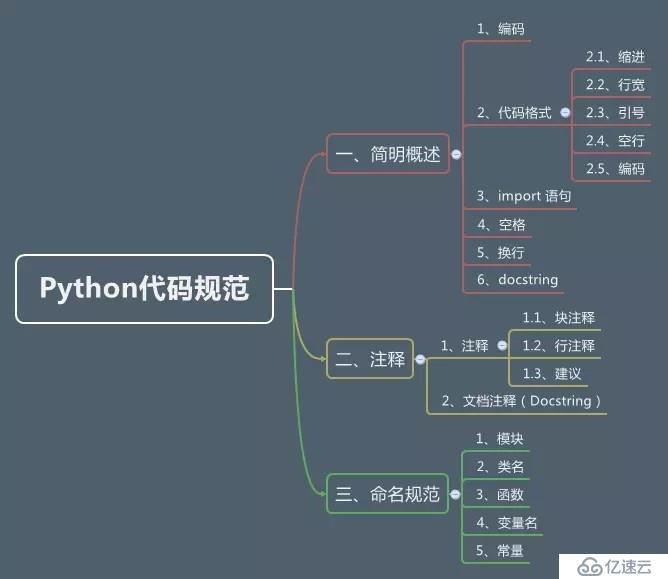您好,登錄后才能下訂單哦!
您好,登錄后才能下訂單哦!
Python 學習之旅,先來看看 Python 的代碼規范,讓自己先有個意識,而且在往后的學習中慢慢養成習慣。

#-*-coding:utf-8-*-標識每行代碼盡量不超過 80 個字符(在特殊情況下可以略微超過 80 ,但最長不得超過 120)
理由:
簡單說,自然語言使用雙引號,機器標示使用單引號,因此代碼里多數應該使用單引號
自然語言 使用雙引號"..."
例如錯誤信息;很多情況還是 unicode,使用u"你好世界"
機器標識 使用單引號'...'
例如 dict 里的 key
r"...""""......"""class A:
def __init__(self):
pass
def hello(self):
pass
def main():
pass 可以使用多個空行分隔多組相關的函數
函數中可以使用空行分隔出邏輯相關的代碼
# 正確的寫法
import os
import sys
# 不推薦的寫法
import sys,os
# 正確的寫法
from subprocess import Popen, PIPE# 正確的寫法
from foo.bar import Bar
# 不推薦的寫法
from ..bar import Barimport os
import sys
import msgpack
import zmq
import foofrom myclass import MyClassimport bar
import foo.bar
bar.Bar()
foo.bar.Bar()[=,-,+=,==,>,in,is not, and]:# 正確的寫法
i = i + 1
submitted += 1
x = x * 2 - 1
hypot2 = x * x + y * y
c = (a + b) * (a - b)
# 不推薦的寫法
i=i+1
submitted +=1
x = x*2 - 1
hypot2 = x*x + y*y
c = (a+b) * (a-b),之后要有空格# 正確的寫法
def complex(real, imag):
pass
# 不推薦的寫法
def complex(real,imag):
pass# 正確的寫法
def complex(real, imag=0.0):
pass
# 不推薦的寫法
def complex(real, imag = 0.0):
pass# 正確的寫法
spam(ham[1], {eggs: 2})
# 不推薦的寫法
spam( ham[1], { eggs : 2 } )# 正確的寫法
dict['key'] = list[index]
# 不推薦的寫法
dict ['key'] = list [index]# 正確的寫法
x = 1
y = 2
long_variable = 3
# 不推薦的寫法
x = 1
y = 2
long_variable = 3Python 支持括號內的換行。這時有兩種情況。
foo = long_function_name(var_one, var_two,
var_three, var_four)def long_function_name(
var_one, var_two, var_three,
var_four):
print(var_one)使用反斜杠\換行,二元運算符+ .等應出現在行末;長字符串也可以用此法換行
session.query(MyTable).\
filter_by(id=1).\
one()
print 'Hello, '\
'%s %s!' %\
('Harry', 'Potter')禁止復合語句,即一行中包含多個語句:
# 正確的寫法
do_first()
do_second()
do_third()
# 不推薦的寫法
do_first();do_second();do_third();if/for/while一定要換行:
# 正確的寫法
if foo == 'blah':
do_blah_thing()
# 不推薦的寫法
if foo == 'blah': do_blash_thing()docstring 的規范中最其本的兩點:
"""Return a foobar
Optional plotz says to frobnicate the bizbaz first.
"""
"""Oneline docstring"""“#”號后空一格,段落件用空行分開(同樣需要“#”號)
# 塊注釋
# 塊注釋
#
# 塊注釋
# 塊注釋至少使用兩個空格和語句分開,注意不要使用無意義的注釋
# 正確的寫法
x = x + 1 # 邊框加粗一個像素
# 不推薦的寫法(無意義的注釋)
x = x + 1 # x加1在代碼的關鍵部分(或比較復雜的地方), 能寫注釋的要盡量寫注釋
比較重要的注釋段, 使用多個等號隔開, 可以更加醒目, 突出重要性
app = create_app(name, options)
# =====================================
# 請勿在此處添加 get post等app路由行為 !!!
# =====================================
if __name__ == '__main__':
app.run() 作為文檔的Docstring一般出現在模塊頭部、函數和類的頭部,這樣在python中可以通過對象的doc對象獲取文檔.
編輯器和IDE也可以根據Docstring給出自動提示.
# -*- coding: utf-8 -*-
"""Example docstrings.
This module demonstrates documentation as specified by the `Google Python
Style Guide`_. Docstrings may extend over multiple lines. Sections are created
with a section header and a colon followed by a block of indented text.
Example:
Examples can be given using either the ``Example`` or ``Examples``
sections. Sections support any reStructuredText formatting, including
literal blocks::
$ python example_google.py
Section breaks are created by resuming unindented text. Section breaks
are also implicitly created anytime a new section starts.
"""# 不推薦的寫法(不要寫函數原型等廢話)
def function(a, b):
"""function(a, b) -> list"""
... ...
# 正確的寫法
def function(a, b):
"""計算并返回a到b范圍內數據的平均值"""
... ...def func(arg1, arg2):
"""在這里寫函數的一句話總結(如: 計算平均值).
這里是具體描述.
參數
----------
arg1 : int
arg1的具體描述
arg2 : int
arg2的具體描述
返回值
-------
int
返回值的具體描述
參看
--------
otherfunc : 其它關聯函數等...
示例
--------
示例使用doctest格式, 在`>>>`后的代碼可以被文檔測試工具作為測試用例自動運行
>>> a=[1,2,3]
>>> print [x + 3 for x in a]
[4, 5, 6]
"""文檔注釋不限于中英文, 但不要中英文混用
文檔注釋不是越長越好, 通常一兩句話能把情況說清楚即可
模塊、公有類、公有方法, 能寫文檔注釋的, 應該盡量寫文檔注釋
參考文檔:https://www.python.org/dev/peps/pep-0008/
參考文檔:https://zh-google-styleguide.readthedocs.io/en/latest/google-python-styleguide/python_style_rules
免責聲明:本站發布的內容(圖片、視頻和文字)以原創、轉載和分享為主,文章觀點不代表本網站立場,如果涉及侵權請聯系站長郵箱:is@yisu.com進行舉報,并提供相關證據,一經查實,將立刻刪除涉嫌侵權內容。